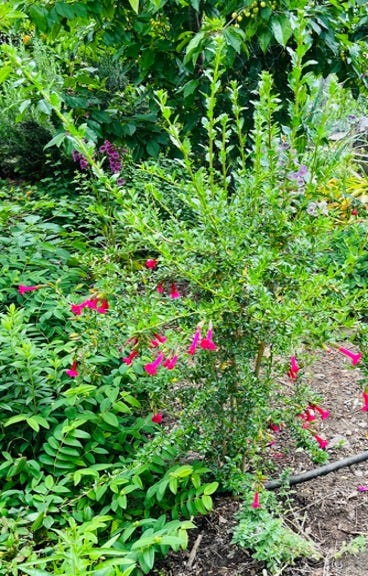NAPA VALLEY, Calif. — Most likely you have been to a garden center and made impulse purchases of plants that struck you as particularly attractive. I’ve done so myself. Even if you read the label carefully, that plant might lose its luster after a few weeks or decline until it’s ready for the compost bin. Sometimes I only find out years later why my kangaroo paws, jacaranda and avocado died an untimely death.

Over the years I have learned that as long as the plant shows some green color it might be worth investigating why it is ailing. The Master Gardeners’ Help Desk can sometimes assist with that research.
Unless the plant has an incurable disease, consider digging it up and finding a more suitable spot for it — even a temporary home in a clean container with fresh potting soil. I once attempted to grow a bougainvillea that I had inherited from a Southern California friend. I had it in a 4-gallon pot in a sunny location against the house, but one 27 degree night killed it. A mature vine just two blocks south of us survived just fine.
I attempted to grow tomatoes in various sunny locations in my Napa garden for at least three years before realizing that most of those areas were infested with a soil-borne fungus. No wonder I had trouble harvesting a bountiful crop.
These failures taught me a few lessons. Rotating crops in the vegetable garden is a sound cultural practice. Vegetables in the same plant family (like tomatoes, eggplants and peppers) should not be grown in the same spot year after year. Put them on a three-year rotation to discourage soil-borne diseases from getting a foothold.
It’s also essential to protect sensitive or tender plants from weather extremes. My new bougainvillea survived this past winter with a bit of frost protection on chilly nights, and my hostas are now vibrant in full shade without any direct sun.
Climate change is causing more extreme weather events that can challenge our plants, so it may be time to rethink what we can successfully grow in Napa County. In my own garden I am testing plants from other Mediterranean climates (South Africa, southwestern Australia, Chile, North Africa, western Asia and southern Europe) to see how well they do during heat waves and winter downpours.
Most plants from these regions require good drainage. I’ve had success with trees and shrubs that don’t thrive in clay soils by growing them in raised beds or containers. I’ve successfully grown tender plants that reportedly would not thrive or survive in Sunset climate zone 14 or USDA climate zone 9. By providing frost protection during their first few years, I can keep the plants safe until they become hardier.
I prepared my own well-draining peatless planting mix to try growing shrubs in the Protea family, so far with reasonable success. A Sacred Flower of the Andes (Cantua buxifolia) that I planted from a 4-inch pot last October in a spot with afternoon shade is now 5 feet tall. From March through June it was covered with brilliant magenta blossoms that the hummingbirds loved.
I am considering using this plant in a low hedge to visually separate the shed area in our orchard. It seems to be much more disease-resistant than boxwood and, like boxwood, it can easily be trimmed into hedges and topiaries.
I intend to acquire more unusual plants – perhaps even some trees – in the future to find out how they like different parts of my garden. I’ll keep good notes on how they are doing, even in the most challenging spots of dry shade in my backyard.
Food-growing forum: Join UC Master Gardeners of Napa County for “Rooting for Root Vegetables” on Sunday, Sept. 10, from 3 to 4 p.m. via Zoom. Root vegetables grow readily from seed sown in September’s warm weather, just as the rest of the garden starts to wane. Beets, carrots, turnips and other root veggies benefit from cooler weather, getting sweeter and juicier as temperatures drop. Learn how to plant and care for these root crops, which you can harvest well into fall. Register to receive the Zoom link.
Gardening with the Masters: Join UC Master Gardeners of Napa County on Saturday, Sept. 16, from 10 a.m. to noon for a workshop at OLE Health Garden, 300 Hartle Court, Napa. Children accompanied by an adult are welcome. Class size is limited. Register to attend.
Fall faire: Join UC Master Gardeners of Napa County for “A Gardening Science Fair for All Ages” on Saturday, Sept. 30, from 1 to 4 p.m. at Las Flores Community Center, 4300 Linda Vista Ave., Napa. Get more details here.
Help desk: The Master Gardener Help Desk is available to answer your garden questions on Mondays and Fridays from 10 a.m. until 1 p.m. at the UC Cooperative Extension Office, 1710 Soscol Ave., Suite 4, Napa. Or send your questions to mastergardeners@countyofnapa.org. Include your name, address, phone number and a brief description of the problem. For best results, attach a photo.
Rainer Hoenicke is a UC Master Gardener of Napa County.





Great column! (Most of us gardeners can relate to failure.)
Thanks Rainer! You are a wealth of knowledge